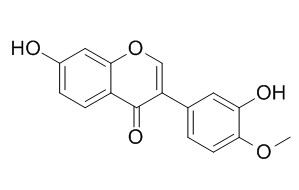Natural Products
Calycosin
| Catalog No. | CFN99140 |  |
| CAS No. | 20575-57-9 | |
| Molecular Weight: | 284.26 | |
| Molecular Formula | C16H12O5 | |
| DBs | [PubChem]:274951278 [ChEMBL]:17793 [PCIDB]:9389 |
Standard InChI:
InChI=1S/C16H12O5/c1-20-14-5-2-9(6-13(14)18)12-8-21-15-7-10(17)3-4-11(15)16(12)19/h2-8,17-18H,1H3
Biological Activity
Calycosin, a major isoflavonoid isolated from Radix Astragal, induces angiogenesis in human umbilical vein endothelial cell cultures (HUVEC) in vitro and zebrafish embryos in vivo via the up-regulation of vascular endothelial growth factor (VEGF), VEGFR1 and VEGFR2 mRNA expression;it acts similar to other selective estrogen receptor modulators (SERMs) to promote angiogenesis via activation of MAPK with the involvement of ERK1/2 and ER. , such as raloxifene and tamoxifen, by displaying selective potency and affinity to estrogen receptors ERa and ERb.[1]
Calycosin has neuroprotective effects in cerebral ischemia/reperfusion rats, and the molecular mechanisms may correlate with the positive feedback between ER-α and miR-375, along with the regulation of downstream targets.[2]
Calycosin inhibits growth and induce apoptosis in ER-positive breast cancer cells, which is mediated by ER-α-induced inhibition of IGF-1R, along with the selective regulation of MAPK and phosphatidylinositol 3-kinase (PI3K)/Akt pathways.[3]
Calycosin can promote proliferation of estrogen receptor-positive cells via estrogen receptors and ERK1/2 activation in vitro and in vivo.[4]
Calycosin can reduce advanced glycation end products-induced macrophage migration and adhesion to endothelial cells and relieve the local inflammation; furthermore, this effect is via estrogen receptor-ERK1/2–NF-κB pathway.[5]
Calycosin is a vasorelaxant, its action is endothelium-independent and is unrelated to intracellular Ca(2+) release; it is also a noncompetitive Ca(2+) channel blocker, the effect of it on Ca(2+) channel blockade may be different from that of dihydropyridines. [6]
Product
References
[1] Tang J Y, Li S, Li Z H, et al. Plos One, 2010, 5(7): e11822.
[2] Wang Y, Dong X, Li Z, et al. J the Neurol Sci, 2014, 339(2):144-8.
[3] Chen J, Hou R, Zhang X, et al. Plos One, 2014, 9(3):e91245.
[4] Chen J, Liu L, Hou R, et al. Cancer Lett, 2011, 308(2):144-51.
[5] Xu Y, Feng L, Wang S, et al. J Ethnopharmacol, 2011, 137(1):359-70.
[6] Xiu-li, Yin-ye, WANG, et al. Acta Pharmacol Sin, 2006, 27(8):1007–12.
[7] Wang H, Yang L I, Fang L, et al. J Pharm Practice, 2015(01):53-4.
Product Use Citation





